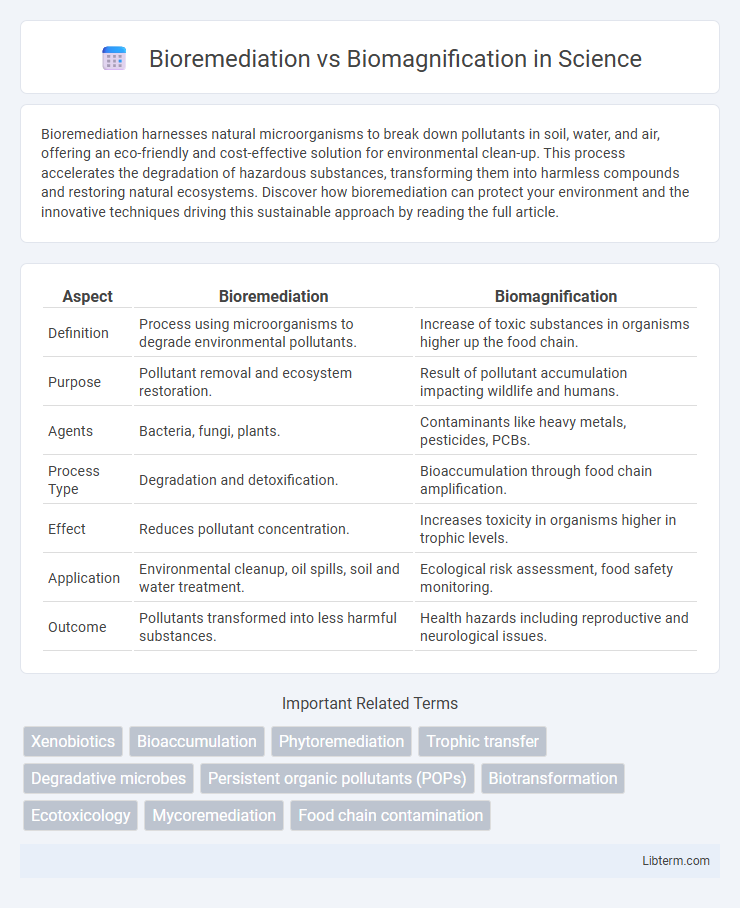Bioremediation harnesses natural microorganisms to break down pollutants in soil, water, and air, offering an eco-friendly and cost-effective solution for environmental clean-up. This process accelerates the degradation of hazardous substances, transforming them into harmless compounds and restoring natural ecosystems. Discover how bioremediation can protect your environment and the innovative techniques driving this sustainable approach by reading the full article.
Table of Comparison
| Aspect | Bioremediation | Biomagnification |
|---|---|---|
| Definition | Process using microorganisms to degrade environmental pollutants. | Increase of toxic substances in organisms higher up the food chain. |
| Purpose | Pollutant removal and ecosystem restoration. | Result of pollutant accumulation impacting wildlife and humans. |
| Agents | Bacteria, fungi, plants. | Contaminants like heavy metals, pesticides, PCBs. |
| Process Type | Degradation and detoxification. | Bioaccumulation through food chain amplification. |
| Effect | Reduces pollutant concentration. | Increases toxicity in organisms higher in trophic levels. |
| Application | Environmental cleanup, oil spills, soil and water treatment. | Ecological risk assessment, food safety monitoring. |
| Outcome | Pollutants transformed into less harmful substances. | Health hazards including reproductive and neurological issues. |
Introduction to Bioremediation and Biomagnification
Bioremediation involves the use of microorganisms or plants to detoxify and restore polluted environments by breaking down harmful contaminants into less toxic forms. Biomagnification refers to the progressive accumulation of toxic substances, such as heavy metals or persistent organic pollutants, within the tissues of organisms at increasingly higher levels of the food chain. Understanding bioremediation offers effective strategies for environmental cleanup, while recognizing biomagnification highlights risks of contaminant amplification in ecosystems.
Defining Bioremediation: Mechanisms and Techniques
Bioremediation involves the use of microorganisms, fungi, or plants to degrade or detoxify harmful pollutants in soil, water, and air, employing mechanisms such as microbial metabolism and enzymatic breakdown to convert contaminants into less toxic forms. Key techniques include bioaugmentation, which introduces specialized microbial strains, and biostimulation, enhancing native microbial activity through nutrient addition. This process contrasts biomagnification, where toxic substances accumulate and intensify through the food chain, posing environmental and health risks.
Understanding Biomagnification: Processes and Impacts
Biomagnification involves the increasing concentration of toxic substances, such as heavy metals and persistent organic pollutants, as they move up the food chain from producers to apex predators. This process significantly impacts ecosystems by causing harmful effects on wildlife, including reproductive failures and population declines. Understanding biomagnification is crucial for assessing environmental health risks and implementing strategies to reduce contaminant exposure in food webs.
Key Differences Between Bioremediation and Biomagnification
Bioremediation is a process that uses microorganisms or plants to degrade or remove environmental pollutants, enhancing ecosystem recovery and reducing contaminant levels. Biomagnification refers to the increasing concentration of toxic substances, such as heavy metals or pesticides, as they move up the food chain, leading to higher exposure and potential harm to apex predators and humans. The key difference lies in bioremediation's goal of pollution reduction and ecosystem restoration, while biomagnification highlights the accumulation and amplification of toxins within biological systems.
Environmental Benefits of Bioremediation
Bioremediation uses microorganisms to break down pollutants, effectively reducing toxic substances in soil and water, which helps restore ecosystems and improves public health. Unlike biomagnification, where harmful chemicals accumulate and intensify through the food chain, bioremediation minimizes environmental contaminants without causing bioaccumulation. This eco-friendly process supports sustainable environmental management by enhancing soil fertility and promoting natural degradation of hazardous waste.
Ecological Threats Posed by Biomagnification
Biomagnification poses significant ecological threats by increasing toxic chemical concentrations as they move up the food chain, adversely affecting apex predators and disrupting ecosystem stability. Persistent pollutants like mercury, DDT, and PCBs accumulate in organisms, causing reproductive failures, immune system impairments, and population declines. Unlike bioremediation, which utilizes microorganisms or plants to degrade contaminants and restore environmental health, biomagnification amplifies contamination risks and biodiversity loss in aquatic and terrestrial habitats.
Case Studies: Successful Bioremediation Projects
Successful bioremediation projects have effectively detoxified polluted environments by using microorganisms to degrade contaminants, exemplified by the Exxon Valdez oil spill cleanup where microbial communities accelerated hydrocarbon breakdown. Case studies from the Chernobyl nuclear disaster site highlight bacterial strains that reduce radioactive waste bioavailability, contrasting with biomagnification processes that increase toxin concentrations up the food chain, as seen with mercury in aquatic ecosystems. These cases demonstrate bioremediation's potential to mitigate environmental pollutants, reducing risks associated with biomagnification-driven toxicity in wildlife and humans.
Real-World Examples of Biomagnification in Food Chains
Biomagnification occurs when toxic substances like mercury and DDT accumulate in organisms at increasing concentrations up the food chain, exemplified by high mercury levels in predatory fish such as tuna and swordfish. These contaminants pose significant health risks to humans consuming top predators due to their ability to magnify through aquatic ecosystems. In contrast, bioremediation harnesses microorganisms to degrade pollutants, effectively reducing toxic load in contaminated environments like oil spill sites and heavy metal-polluted soils.
Strategies for Promoting Bioremediation and Preventing Biomagnification
Promoting bioremediation involves strategies such as optimizing environmental conditions, including pH, temperature, and nutrient availability, to enhance microbial degradation of pollutants. Techniques like bioaugmentation, the introduction of specialized microbial strains, and biostimulation, the addition of nutrients or substrates, accelerate the breakdown of contaminants in soil and water. Preventing biomagnification requires controlling the release of persistent organic pollutants (POPs) and heavy metals, enforcing strict regulations on industrial discharges, and monitoring food chains to minimize the accumulation and amplification of toxic substances in apex predators.
Future Perspectives: Innovations in Bioremediation and Controlling Biomagnification
Emerging innovations in bioremediation leverage genetically engineered microorganisms and advanced nanotechnology to accelerate the degradation of persistent pollutants, offering sustainable solutions for environmental cleanup. Cutting-edge bioaugmentation strategies are enhancing the efficiency of contaminant removal in diverse ecosystems, while synthetic biology paves the way for tailored microbial consortia capable of targeting specific toxins. Controlling biomagnification involves integrating these bioremediation advancements with real-time monitoring systems and ecological modeling to predict and mitigate the trophic transfer of harmful substances, ultimately reducing risks to human and wildlife health.
Bioremediation Infographic

 libterm.com
libterm.com